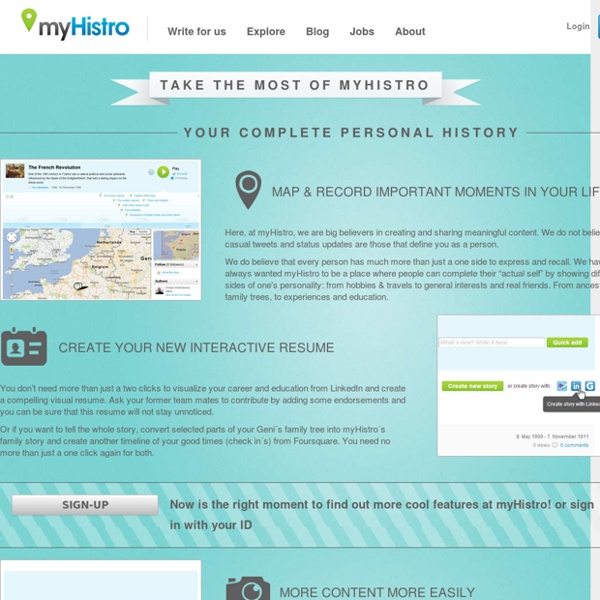Crash Course - Mythology
Cities of Myth: Crash Course World Mythology #35 Mythical Trees: Crash Course World Mythology #34 Mythical Mountains: Crash Course World Mythology #33 Mythical Caves and Gardens: Crash Course World Mythology #32
Des outils pour construire des frises chronologiques
Avec le logiciel PowerPoint OfficeTimeline est un plugin gratuit pour PowerPoint sous Windows permettant de réaliser des timelines (échelles de temps) facilement. Après enregistrement et téléchargement du composant (6mo) vous pourrez lancer l’installation. Pour Office 2007, vous aurez besoin d’installer au préalable Visual Studio Tools, via le fichier setup.exe. Un menu supplémentaire prend place dans le bandeau de PowerPoint, c'est depuis ce menu que vous pourrez construire vos frises : Exemple de réalisation :
Beautiful web-based timeline software
Teacher Ms. Isabel
First at all we shoul cast a glance to this timeline of Ancient Rome where are shown the most important moments of its history. Life in Rome was very different as it is now, specially for women and children. To understand it better here you have two videos.
1º ESO - TIC IES Albayzín
D. Javier Paños Gracia (1º ESO A - bilingüe) Da. Marta Rivas Martínez (1º ESO B y C - bilingües) Aquí podéis encontrar todos los materiales y recursos que empleamos en la clases de CCiencias Sociales bilingües: las presentaciones de Power Point, las actividades interdisciplinares del Curriculum Integrado bilingüe, las páginas web y actividades on-line que usaremos en clase.
Bilinguex: Rúbricas
¿Qué son las rúbricas? Las rúbricas son guías de puntuación usadas en la evaluación del desempeño de los estudiantes que describen las características específicas de un producto, proyecto o tarea en varios niveles de rendimiento, con el fin de clarificar lo que se espera del trabajo del alumno, de valorar su ejecución y de facilitar la proporción de feedback (retroalimentación) (Andrade, 2005; Mertler, 2001) a través de Fernández, A. Revista de Docencia Universitaria Vol. 8 (n. 1) 2010.
Bilinguex: Geography/History
Recursos para Ciencias Sociales e HistoriaGeography/History, by bilinguex Geohistonetbilingual Secuencias didácticas AICLE para Ciencias Sociales.
CLIL Teachers´ Web Guide
According to Voltaire, history consists of a series of accumulative imaginative inventions. Let´s discover some of these inventions in the following websites. Explore The British Museum website, which offers extensive information and pictures about the ancient civilizations.
Geography
Join our email newsletter to receive free updates! Close Search for Ideas and Resources Filter Results Menu
History - 1 ESO Geography and History
The presentation about the Paleolithic is on the link below. Remember that these are just the basic concepts. You need to study from your book, too. The link to the presentation about the Metal Age: Click on this link to watch the presentation about the Egyptian gods: The presentation about Rome is online.
Egypt's Pyramids: Monuments with a Message
Activity 1. Messages in Stone Now that the students know where the pyramids are and how big they are, ask them what these great structures tell us about the ancient Egyptians by observing and analyzing the following tomb artifacts from University of Memphis Museum Detroit Institute of Arts Odyssey Online
Life in Old Babylonia: The Importance of Trade
Activity 1. How Do We Know the Babylonians Traded? In this activity, students refer to a natural resource map of the region to learn the source of materials for Old Babylonian artifacts reviewed online.
GEOGRAPHY, LAND AND WEATHER MESOPOTAMIA
Baylonian maps Strategically situated in the heart of the Near East and northeastern part of the Middle East, Mesopotamia was located south of Persia (Iran) and Anatolia (Turkey), east of ancient Egypt and the Levant (Lebanon, Israel, Jordan and Syria) and east of the Persian Gulf. Almost completely landlocked, its only outlet to sea is the Fao peninsula, a small chunk of land wedged between modern-day Iran and Kuwait, which opens to the Persian Gulf, which in turn opens into the Arabian Sea and the Indian Ocean. Much of the agricultural land is in the fertile valleys and plains between the Tigris and Euphrates and their tributaries. Much of the agricultural land was irrigated.
New Human Ancestor Elicits Awe—and Many Questions
Scientists reacted with a mix of awe and exasperation to the news Thursday of the discovery of fossils in South Africa that are said to define a new species of human ancestor, Homo naledi. The awe was inspired mostly by the sheer number of fossils—more than 1,500 bones, all of them from a remote chamber in the cave system called Rising Star, 30 miles northwest of Johannesburg. “It’s a stunning collection of bones, unlike any we’ve seen before,” said Carol Ward, a paleoanthropologist at the School of Medicine at the University of Missouri. Like other scientists, however, Ward tempered her enthusiasm with frustration at the discovery team’s decision to publish before more information could be gathered—most importantly, on the age of the bones. Homo naledi sports a bizarre mixture of primitive and modern traits.



